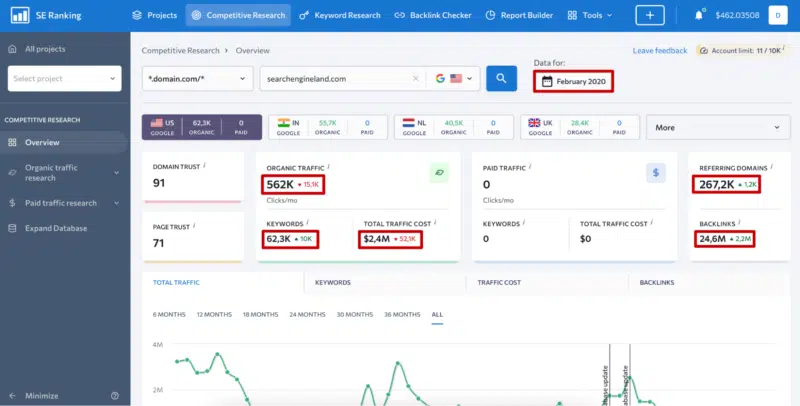

Google’s SERP is a very competitive environment. For this reason, getting competitive intelligence on its players is a crucial process that helps understand how the search giant assesses various website search campaign activities.
The problem is that when you look at a competitor’s current data, you don’t see the full picture. In other words, you have no way of knowing what they did in the past to get to where they are now. That is until you reverse engineer the process. This is where historical data comes to the rescue.
This article focuses on how to analyze competitors through the retrospective analysis of their keyword and domain data. Plus, we look into why historical data is important to analyze and why you should prioritize SEO tools that gather such information.
Note that all of the examples herein are based on analytical, historical data provided by SE Ranking.
1. What competitor insights can you get with historical data?
Whenever you start working with a new client or need to analyze a potential client to prepare a pitch, you need to have access to as much data as possible.
Besides closely studying their current data on traffic, backlinks, keywords, and rankings, you can uncover a vast pool of data for previous periods by digging into their historical data.
Historical data is exactly what can show you the logic behind a domain’s previous setup. As in, what the domain owners were doing before and what results this led to.
Say you’re analyzing your client’s niche. Once you put together a list of all of your client’s top and direct search competitors, you can perform a comprehensive retrospective analysis of each digital rival to see what makes them tick and find out how they got to where they are today.
What historical data points should you pay attention to?
Start by analyzing last year’s data on each shortlisted competitor with regard to traffic, backlinks, keywords, and their rankings, and then move up in time month-by-month to identify positive or negative trends.
Please note that whenever you look at a specific data point, you need to analyze it not only in comparison with your client’s site but also see how it correlates with other data points––as they are all interconnected.
- Organic and paid traffic. When analyzing traffic, pay attention to how quickly or slowly a domain’s traffic volume increases each month leading up to real-time data.
- Backlinks and referring domains. During the analysis of the growth dynamics of backlinks and referring domains, it helps to study the Domain Trust of referring domains, their dofollow/nofollow status, as well as the anchor text.
- Keywords. In terms of keywords, pay close attention to their overall number and whether that number went up or down with each month.
- Keyword rankings. Lastly, analyze the keyword rankings dynamics. More specifically, look at how many keywords were ranking among the top 3, 10, 30, 50, 100, and beyond each month.
You can actually look at more data points than the ones outlined here, but we are going to limit the analysis to the most important ones.
Analyzing the data
Once we collect information on these data points and know what their value was each month, we’re able to reveal a lot of actionable insights. Focus on domains that are showing steady growth to uncover opportunities, and analyze less successful ones to avoid repeating their mistakes.
The big question here that you want to get an answer to is this: Which strategy yielded the best results with minimum investments?
With the power of this data, you can look at each domain and find out if, for example, the site was able to drive more traffic by getting links from referring domains with a high Domain Trust score, or if the total amount of target keywords helped the site increase the number of organic visitors.
By gradually moving back in time, you can discover the small steps that were taken by a domain along the way and use that data to improve your clients’ future strategies. Moreover, you can understand if a search engine update caused the SERP players to move around or whether the players’ strategies are, in fact, responsible for their success or failure.
Without access to such historical data, you can waste valuable time and resources doing the guesswork and experimentation yourself. But learning from other people’s mistakes can fast-track your clients’ success.
Now that we’ve covered the value you can get from analyzing historical data on domains, let’s take a look at the benefits of using historical data when working with client websites.
2. Boosting client visibility through historical domain data
Historical data on website traffic and rankings can help figure out what advantages and drawbacks to expect from investing in organic and paid search engine optimization efforts.
On top of that, by analyzing your clients’ previous achievements along with the work that’s been carried out on their sites and comparing it to their competitors, you will be able to make market predictions with greater accuracy.


In SE Ranking’s Competitive Research tool, you can get plenty of SEO insights on the past, going back to February 2020. Naturally, every month the tools get updated with a set of data for the previous month.
Let’s dive into the tool to see some of the ways SEOs and marketers can take advantage of historical data on domain traffic and rankings.
Have the data to make a great first impression with clients
A big part of working with clients has to do with getting pitches ready, which ideally must convince them to do business with you. But there is one problem that makes it difficult to obtain enough data to have a clear picture of the client’s market share: you can’t access any client accounts to dig into their data. To boot, you can’t access their competitors’ accounts either, but that’s always the case.
To solve this problem, SEO experts leverage paid solutions like SE Ranking’s Competitive Research to get market and SEO data that gives them the necessary historical insights. Through such tools, experts are able to paint a good picture of the journeys client websites went through, as well as their competitors. This ultimately allows agencies to put forward a strategic plan that is a lot more insightful and actionable.
Get more data when gathering competitive intelligence
Having an understanding of how quickly client competitors advance in SERPs and climb the rankings ladder can shed light on the search environment for digital experts. Once agencies have that historical rankings and traffic data on client competition, they are free to compare how their clients and their clients’ digital rivals move forward in search and understand the pace at which client websites need to go in order to reach the set goals.
So, besides using such tools to get historical data on client websites, you are encouraged to dig into the competition as well to gain a competitive edge on the market.
Access historical insights from day one
The vast majority of SEO solutions on the market don’t give you the opportunity to import relevant performance data from other SEO solutions seamlessly. This means that once you sign up for a new SEO tool, you don’t have any way of going back in time through search engine results pages. In most cases, such tools only provide data starting from the date you add the website to the tool as a project and specify which keywords you want to target.
Since SEO experts and digital marketers can’t afford to lose such valuable historical data at the risk of drawing the wrong SEO conclusions, they tend to strongly avoid switching their software solutions.
With SE Ranking’s Competitive Research tool, you can get your hands on practically the same historical data on traffic and rankings that you have in your current tool. Sure, it’s not the ideal solution, but it does allow us to see how current results compare to past achievements, regardless of whether or not you were keeping track of a website’s search performance.
Over to you
Historical organic and paid data from Google on domains is practically priceless to SEOs and digital marketers. It’s like going on a treasure hunt guided by a map, which in this case is represented by historical data. Obviously, X doesn’t mark the spot here, but it sure does help stay on the right track towards success.
Through the power of this data, experts working with clients can get an understanding of past progress, strategy evolution, competitor movement to ultimately put forward a very well-informed SEM and SEO strategy. The best part is that you won’t have to play catch-up if you do decide to switch to a new SEO software solution like SE Ranking—all the data is there as soon as you sign up.
Time travel has already been invented, but at the moment, it only allows us to travel through Google’s SERPs.
Boost your SEO Strategy with Historical Data



